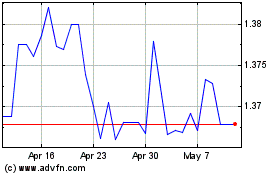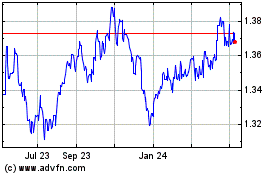Canadian Dollar Spikes Up As BoC Lifts Benchmark Rate Unexpectedly
September 06 2017 - 5:40AM
RTTF2
The Canadian dollar climbed against its key counterparts in
early New York deals on Wednesday, as the Bank of Canada raised its
benchmark rate unexpectedly given recent stronger-than-expected
economic data.
The BoC upped its key interest rate to 1 percent from 0.75
percent. Economists had forecast the rate to remain unchanged.
In its accompanying statement, the BoC noted that the recent
economic data had been stronger than expected, supporting the
Bank's view that growth in Canada is becoming more broadly-based
and self-sustaining.
The Bank continues to expect a moderation in the pace of
economic growth in the second half of 2017, although the pace of
growth is now higher than the Bank had expected, it added.
Meanwhile, caution prevailed as North Korea warned of "more gift
packages" to the United States just days after it successfully
carried out a hydrogen bomb test.
Also, investors are eager to see whether the European Central
Bank will send a new policy message regarding the timing of an exit
from its ultra-loose monetary policy at its policy meeting,
scheduled for Thursday.
Data from Statistics Canada showed that Canada's merchandise
trade deficit narrowed to C$3.0 billion in July from C$3.8 billion
in June. Economists had forecast a shortfall of C$3.3 billion
Imports fell 6.0 percent, while exports decreased 4.9 percent.
The European Central Bank meets on Thursday and it isn't
entirely clear whether the central bank will send a new policy
message regarding the timing of an exit from its ultra-loose
monetary policy.
The loonie slipped against its major rivals in the Asian
session, as Asian shares fell amid geopolitical concerns following
North Korea's nuclear test on Sunday.
The loonie climbed to 1.2136 against the greenback, a level not
seen since June 2015. Continuation of the loonie's uptrend may see
it challenging resistance around the 1.17 region.
The loonie reversed from an early 5-day low of 1.4812 against
the euro, reaching a 1-1/2-month high of 1.4484. The loonie is
poised to target 1.43 as the next resistance level.
Figures from Destatis showed that German factory orders declined
unexpectedly in July on weak domestic demand.
Factory orders fell 0.7 percent month-on-month in July, in
contrast to a revised 0.9 percent rise in June. This was the first
fall in three months. The loonie spiked up to a 21-month high of
89.74 against the Japanese yen, after having fallen to a 6-day low
of 87.55 at 3:00 am ET. The next possible resistance for the
loonie-yen pair is seen around the 92.00 mark.
Preliminary report from the Ministry of Health, Labor and
Welfare showed that Japan's total labor cash earnings decreased for
the first time in fourteen months in June, defying economists'
forecast for a further rise.
Gross earnings dropped 0.3 percent year-over-year in July,
reversing 0.4 percent rise in May, which was revised from a 0.4
percent fall estimated previously.
Following a 5-day low of 0.9926 hit at 9:15 pm ET, the loonie
reversed direction and strengthened to an 8-month high of 0.9676
against the aussie. The loonie is seen finding resistance around
the 0.95 mark. Looking ahead, at 2:00 pm ET, U.S. Federal Reserve
releases Beige Book report.
US Dollar vs CAD (FX:USDCAD)
Forex Chart
From Mar 2024 to Apr 2024

US Dollar vs CAD (FX:USDCAD)
Forex Chart
From Apr 2023 to Apr 2024
